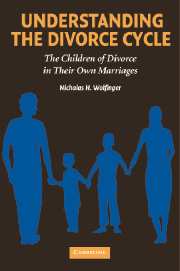Book contents
- Frontmatter
- Contents
- Preface
- Acknowledgments
- 1 Introduction
- 2 Why Divorce Begets Divorce
- 3 Coupling and Uncoupling
- 4 How Strong Is the Divorce Cycle?
- 5 Historical Developments
- 6 The Cohabitation Revolution
- 7 Conclusion
- Appendix A Data and Methods
- Appendix B Evaluating the Role of Marriage Differentials in the Weakening Divorce Cycle
- Notes
- Bibliography
- Index
3 - Coupling and Uncoupling
Published online by Cambridge University Press: 27 July 2009
- Frontmatter
- Contents
- Preface
- Acknowledgments
- 1 Introduction
- 2 Why Divorce Begets Divorce
- 3 Coupling and Uncoupling
- 4 How Strong Is the Divorce Cycle?
- 5 Historical Developments
- 6 The Cohabitation Revolution
- 7 Conclusion
- Appendix A Data and Methods
- Appendix B Evaluating the Role of Marriage Differentials in the Weakening Divorce Cycle
- Notes
- Bibliography
- Index
Summary
No one can divorce without first getting married. Hence it is important to understand the role marital behavior plays in the divorce cycle. This chapter has two objectives: first, to understand how parental divorce affects marriage timing and rates; and second, to consider the types of people the children of divorce marry. The answers to these questions indicate that the children of divorce often marry under conditions that bode poorly for marital success.
Almost everyone gets married. Despite well-publicized declines in the marriage rate over the past few decades, recent research suggests that the great majority of people – about 90 percent – will wed at some point in their lifetimes. Marriage therefore remains the normal experience for heterosexual Americans, including people from divorced families. Nevertheless, we should not lose sight of the fact that millions of adults will never marry, though many will live with partners out of wedlock – a topic addressed in Chapter 6.
Marriage is often taken for granted, even by social scientists. As a result, we tend to lose sight of its importance. Not only do most people wed, but married men and women on average are happier and better adjusted than either single or divorced people. This is particularly important for the children of divorce, who typically report lower levels of emotional well-being than their peers from intact families. Even though the majority of people from divorced families ultimately will dissolve at least one marriage, a substantial minority will not.
- Type
- Chapter
- Information
- Understanding the Divorce CycleThe Children of Divorce in their Own Marriages, pp. 35 - 52Publisher: Cambridge University PressPrint publication year: 2005



